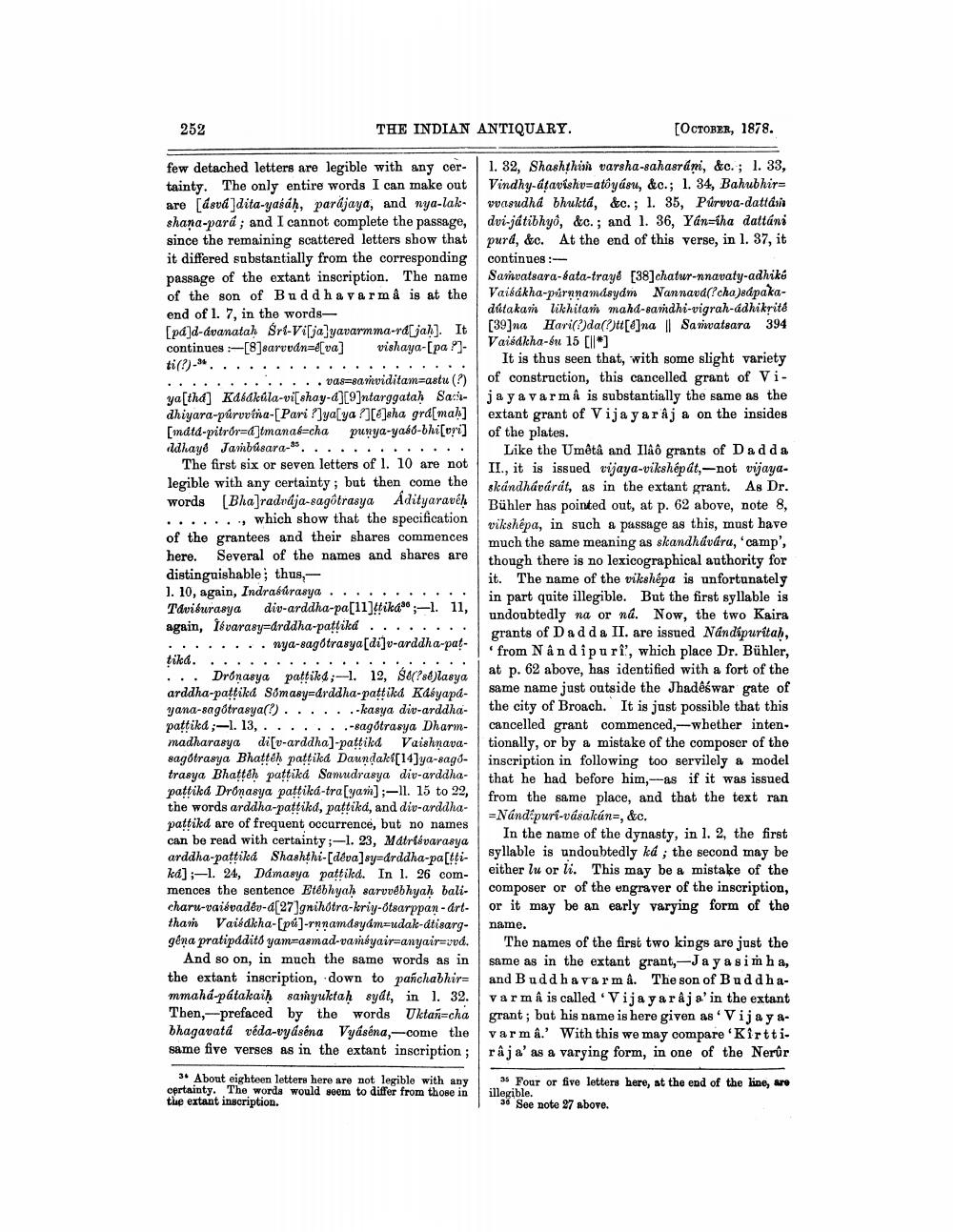________________
252
THE INDIAN ANTIQUARY.
few detached letters are legible with any certainty. The only entire words I can make out are [ásvá]dita-yasáḥ, parajaya, and nya-lakshana-para; and I cannot complete the passage, since the remaining scattered letters show that it differed substantially from the corresponding passage of the extant inscription. The name. of the son of Buddhavarmâ is at the end of 1. 7, in the words[pá]d-dvanatah Sri-Visjayavarmma-rajaḥ]. It vishaya-[pa ?]
continues-[8]sarvván=e[va]
ti(?)-3.
vas-samviditam=astu (?) ya[tha] Kabákúla-vishay-d][9]ntarggataḥ Sachdhiyara-púrovina-[Pari ?]ya[ya ?][]sha grá[mah] [matá-pitror=d]tmanas-cha punya-yabó-bhi[vi] ddhayé Jambúsara-5
The first six or seven letters of 1. 10 are not legible with any certainty; but then come the words [Bharadvaja-sagôtrasya Adityaravéh
which show that the specification of the grantees and their shares commences here. Several of the names and shares are distinguishable; thus,1. 10, again, Indrasúrasya Táviturasya div-arddha-pa[11]ṭṭika;-1. 11, again, Isvarasy-arddha-pattiká
tiká.
nya-sagorasyo[dio-arddha-pa
Dronasya pattika;-1. 12, Se(?sé)lasya arddha-paṭṭiká Sómasy-arddha-paṭṭiká Kasyapáyana-sagotrasya(?). .-kasya div-arddhapaṭṭika;-1. 13, . .-sagótrasya Dharmmadharasya di[v-arddha]-pattika Vaishnavasagotrasya Bhattéh paṭṭiká Daundaki[14]ya-sagstrasya Bhattéh paṭṭiká Samudrasya div-arddhapattika Drónasya pattiká-tra[yam];-11. 15 to 22, the words arddha-pattika, pattiká, and div-arddhapattiká are of frequent occurrence, but no names can be read with certainty;-1. 23, Mátriévarasya arddha-paṭṭiká Shashṭhi-[déva]sy-drddha-pa[ṭṭiká];-1. 24, Dámasya paṭṭikd. In 1. 26 commences the sentence Etébhyaḥ sarvvébhyah balicharu-vaiévadév-d[27]gnihotra-kriy-ôtsarppan-arttham Vaisakha-[pú]-rnnamdayám-udak-átisarggéna pratipádito yam-asmad-vamsyair-anyair-vvá.
And so on, in much the same words as in the extant inscription, down to pañchabhir= mmahá-pátakaiḥ samyuktaḥ sydt, in 1. 32. Then,-prefaced by the words Uktan-cha bhagavatá véda-vyásêna Vyáséna,-come the same five verses as in the extant inscription;
3 About eighteen letters here are not legible with any certainty. The words would seem to differ from those in the extant inscription.
[OCTOBER, 1878.
1. 32, Shashṭhim varsha-sahasrani, &c.; 1. 33, Vindhy-átavishv-atôyásu, &c.; 1. 34, Bahubhir= vvasudha bhuktá, &c.; 1. 35, Púrvva-dattá dvi-játibhyo, &c.; and 1. 36, Yan-iha dattáni pura, &c. At the end of this verse, in 1. 37, it continues:
Samvatsara-bata-trayé [38] chatur-nnavaty-adhiké Vaisakha-parnnamdsydm Nannavá(?cha)sápakadútakam likhitam mahd-samdhi-vigrah-ádhikrité [39]na Hari(?)datt[e]na || Samvatsara 394 Vaisakha-bu 15 [||]
It is thus seen that, with some slight variety of construction, this cancelled grant of Vijayavarmâ is substantially the same as the extant grant of Vijayaraj a on the insides of the plates.
Like the Umêtâ and Ilâô grants of Dadda II., it is issued vijaya-vikshép át,-not vijayaskándhávárát, as in the extant grant. As Dr. Bühler has pointed out, at p. 62 above, note 8, vikshépa, in such a passage as this, must have much the same meaning as skandháváru, 'camp', though there is no lexicographical authority for it. The name of the vikshépa is unfortunately in part quite illegible. But the first syllable is undoubtedly na or na. Now, the two Kaira grants of Dadd a II. are issued Nandipuritaḥ, 'from Nandipuri, which place Dr. Bühler, at p. 62 above, has identified with a fort of the same name just outside the Jhadêśwar gate of the city of Broach. It is just possible that this cancelled grant commenced,-whether intentionally, or by a mistake of the composer of the inscription in following too servilely a model that he had before him,-as if it was issued from the same place, and that the text ran -Nandipuri-vásakún=, &c.
In the name of the dynasty, in 1. 2, the first syllable is undoubtedly ká; the second may be either lu or li. This may be a mistake of the composer or of the engraver of the inscription, or it may be an early varying form of the
name.
The names of the first two kings are just the same as in the extant grant,-Jay a simha, and Buddha varmâ. The son of Buddhavar mâ is called 'Vijayaraja' in the extant grant; but his name is here given as 'Vijayavarma.' With this we may compare 'Kirttirâja' as a varying form, in one of the Nerûr
35 Four or five letters here, at the end of the line, are illegible.
30 See note 27 above.




